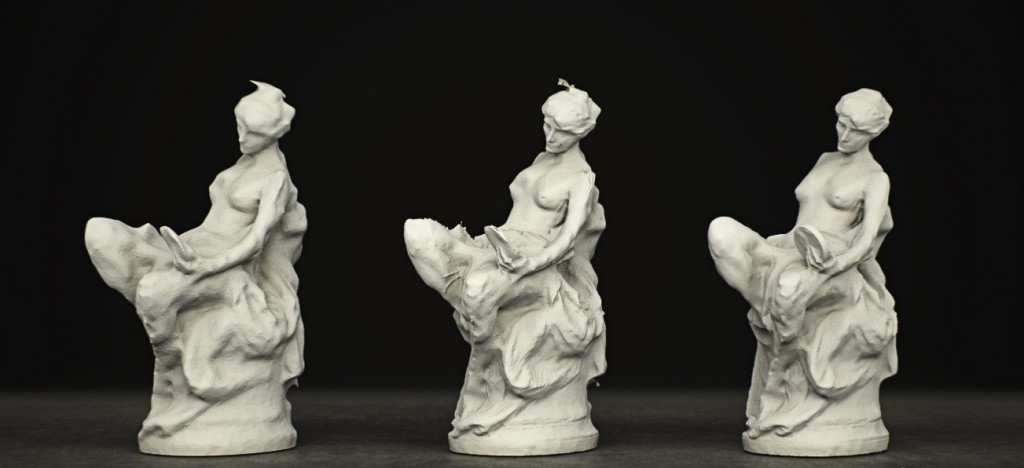
Caveat Emptor, an exhibition of forged artworks confiscated by the FBI, came and went this past July-turned-August, inspiring 100% more conceptual intrigue from the art world than the Bureau would ever burden themselves to consider. In what was essentially a foyer for the 2013 International Conference on Cyber Security held at Fordham University, curators Daniel Small and Stephan Apicella-Hitchcock worked with the FBI Art Crimes division to gather 13 paintings – all knock-offs — for display in the university’s Center Gallery. As a body of evidence, the selection sampled the range of skill involved in the realization and jurisprudence of art fakery. Some works, like “the Chagalls” by masterful art forger Ely Sakhai, were credited with accuracy. But more often than not, the counterfeiter’s identity had either eluded the FBI or wasn’t made available to the public. Such works are only credited with the name of the artist whom they were imitating.
Here is spectatorship laced with cognitive dissonance. You need to throw your usual visual thinking strategies out the window. What are we looking at? These works are evidence of a criminal’s craft, but are they anything more? Inadvertent conceptual art, maybe? As Fordham University’s description states, “The exhibition’s cohesion is challenged by the tension between the paintings’ initial renown and their true makers’ anonymity.” And that’s exactly what makes the exhibition compelling.
A semantic hop and a leap from forgery is parody. On view until mid-September at the University of Memphis Art Museum are the “parody paintings” of a relatively unknown artist, the late Carroll Cloar. As he employed various styles and movements into his tempura (and later, acrylic) paintings, Cloar’s body of work would be resolutely difficult to categorize but for his subject matter: domestic scenes of the Depression-era rural south. Looking at his parodies of famous works by Édouard Manet, Piet Mondrian, Willem deKooning, Morris Graves, Yves Tanguy, and Albert Ryder – all playfully executed throughout the summer of 1960 — reveals something further. The works confirm the depth of his erudition — not only in literature, which he often spoke of enjoying, but also his fluency in the visual arts, a subject about which he often kept mum. Most active from the 1940s to 1980s, here was a guy who left New York City, at the very time it was the epicenter of the avant-garde, to move back to the Mid-South and paint scenes of yesteryear. The parody paintings bring subtle details throughout his oeuvre to new light, particularly his sharp art-historical awareness and wicked sense of humor.
But parody, and satire, seem a bit dated, eh? The terrain of the politically marginalized and oppressed has taken to technology these days. We hack what we hate and can reproduce all that was previously untouchable in culture for our own mantles, to embrace in sum or piecemeal, as we see fit. The hacker ethic – decentralization through openness and sharing – is revolutionary despite its tacit sanction by prevailing establishments. The Metropolitan Museum of Art’s 3-D Hackathon enterprise has even made high art available for free download…sort of. First, you have to download this software and own a 3-D printer (now available under a cool $2K). And you would need to be satisfied with the resulting high art hack looking like a jailhouse soap-carving of the real thing (bathed with once or twice). It’s somehow fitting: We’re using a primitive technology in its nascency, creating by-definition derivative work from our cultural memory. Imagine an uncanny valley of cultural objects — much like the inverted classical bust-casts of sculptor Christian Gonzenbach or the art objects of Matthew Plummer-Fernandez – created through a process of running pop culture through algorithms.
“Somewhere between the gift shop and the gallery” are five high-resolution 3-D Van Gogh prints. They are called “Relievos” — created courtesy of FujiFilm using a patented “Reliefography” process. These reproductions recently went on view at the Gallery by the Harbor in Hong Kong. Some say they are educational things! That they will aid the blind in experiencing heretofore inaccessible aspects of art. I say they are pretty neat-o. While the current “poor man’s” version of 3-D printing may be imperfect, recall what is commonly known as the first photograph, Point de vue du Gras by Nicéphore Niépce. Now compare it to the quality of pictures you can take with your phone. You do the math. As artist/scientist Shane Hope says, “It’s one thing to push pixels or plastic around. It’ll be another thing altogether when it’s atoms.”
Watch a video of humanity’s first general-purpose self-replicating manufacturing machine below (eat your heart out, Robert Morris’ Box with the Sound of Its Own Making).
Get Walker Reader in your inbox. Sign up to receive first word about our original videos, commissioned essays, curatorial perspectives, and artist interviews.